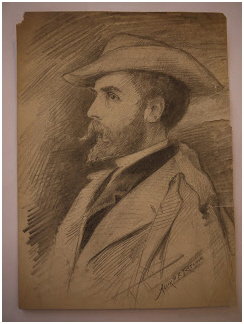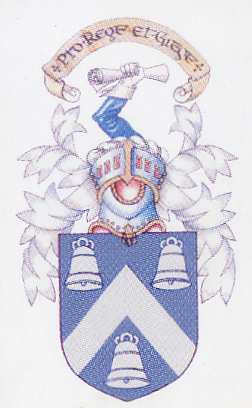|
Former Pupil Biographies
Martin Anderson ( 1854 -
1932)
Martin Anderson was born in Leuchars, Fife, in 1854.
After his mother, Margaret Martin, separated from his father, she
moved with her children to Cambuslang, Glasgow. Anderson studied at
Glasgow School of Art under Robert Greenlees, in Ingram Street
Glasgow. On leaving he worked as a designer at a calico printer.
When he was 19, he founded The St. Mungo Art Club in Glasgow, intended
to be an alternative to the grander Glasgow Art Club. In 1877 he began
to provide small illustrations for serial stories in the short-running
"News of the Week". In 1878 his painting "The Music Lesson" was
accepted for the Royal Scottish Academy's annual exhibition. In 1879,
age 24, he decided to move to London, ("to study art proper" he
explained in an 1894 interview in The Sketch). |
 |
In 1880 he was invited to join John Leng and Co., (the
publisher of titles such as the Dundee Advertiser, the Evening Telegraph,
Peoples Journal, and Peoples Friend), as its staff artist. Accepting the
position, Andersen became the first such artist to be employed by any
daily newspaper in Britain (until then daily newspapers were
un-illustrated). He moved to Broughty Ferry near Dundee.
In 1881, as a freelance artist, he began contributing cartoons and
illustrations to the comic weekly "The Quiz", an imitation of the magazine
"Punch". For his illustrations in The Quiz he used the pseudonym "bob",
but in November 1887 he adopted a second pseudonym, that of "Cynicus", and
began to move away "from the safe and trivial to the dangerous and
powerful realm of politics".
A series of cartoons titled The Satires of Cynicus appeared in The
Quiz in 1888. In 1890 he decided to publish a collected edition of his
more controversial subjects. The Quiz cartoons were redrawn in a larger
size and hand coloured. They were published in six monthly parts, each
part containing two full-page cartoons. However, they did not sell well.
In 1891 he moved back to London in an attempt to get his work noticed,
taking a shop in Drury Lane, with the sign "Cynicus Publishing Company"
over its door and with prints of his cartoons displayed in its windows.
The Satires of Cynicus began to attract public attention and increasing
sales. The edition was limited to 1000 copies, and by the end of 1891 it
was almost out of print.
In 1891 he began contributing work to the "Pall Mall Budget", as well as
to The Idler and "Ariel or the London Puck", yet another rival to Punch.
A second book, titled "The Humours of Cynicus", again containing many
reworked The Quiz cartoons, was partwork published starting in September
1891. The complete 1000-copy edition of the complete volume sold for 25
shillings, with a 100-edition deluxe version priced at 2 guineas. In 1892
he began work on another collection, "Symbols and Metaphors". It was also
issued in parts, like its predecessors. A cheaper edition of The Satires
of Cynicus was published in June 1892, and there were also later reprints
of it.
Postcards
In the late 1890s a new market for his products was quickly emerging –
that of picture postcards. In 1898 Anderson began working for Blum & Degan
where he designed court-sized postcards. In 1902, after the Post Office
allowed divided back postcards, picture postcards became very popular and
also began to be widely collected.
In 1902 Anderson decided to form his own company. The "Cynicus Publishing
Company" was incorporated as a limited company and began publishing colour
postcards by the second half of 1902. Initially, the company did
exceedingly well. However, by 1908 the mass-market popularity of postcards
began to decline and the company suffered from dwindling profitability. In
1911 the North of Scotland Bank forced the company to liquidate its
assets. Its stocks of prints and original artwork were sold by the bank
for a fraction of their true value and without any thought for their
proper market: they were sold in a second-hand furniture salesroom rather
than to art dealers in Edinburgh and London.
In 1912, after the collapse of the Cynicus Publishing Company, Anderson
set up the "Cynicus Art Publishing Company" based in Leeds (the home of
several postcard publishers), and began reissuing his old postcards and
designing new ones. About 100 different postcards are known to have been
printed by the Leeds company until 1914.
WW1
The outbreak of war put an end to the seaside postcard market in Britain,
and Cynicus Art Publishing Company was forced to close. In 1915 Anderson
moved to Edinburgh, leasing a basement shop in York Place. The printing
plates for his postcards were sent from Leeds – but for uncertain reasons,
and without the knowledge of Andersen, they were sold for scrap.
In 1915 he created an allegorical anti-war poster entitled "War!": in a
pyramidal composition, a crowned Mammon sits on a throne, tossing away the
Nation's wealth to an ecstatic crowd clutching sacks marked "War Profits";
a semi-naked Lust caresses him, famine and disease sit at her feet;
Justice and Parliament stand bound and gagged; the Lamp of Truth is
extinguished by censorship; the Church encourages the slaughter. In the
foreground, a bloody river carries away the bodies of the dead while
bankers grab the bank deposits of the dead.
This poster was displayed in his shop window until he was warned he could
be interned without trial under the terms of the Defence of the Realm Act
(DORA). The poster was removed from view, but was made into a postcard
which sold well.
In another allegorical poster titled "The Dictator", produced after the
end of the war, soldiers returning home are greeted by a fat figure
representing Capitalism, seated on a huge sack full of the earnings of
others, using a megaphone titled "The Press" to blast out "Propaganda and
Misrepresentation" and setting his "Black and Tan" dog onto Ireland; the
grave of Liberty and Freedom is trampled over by a truncheon-welding
policeman titled DORA; two more fat figures, representing Lloyd George
(standing on broken pledges) and the Church, carry a banner titled
"Britain's welcome to the Troops" that frames the entrance to a poorhouse.
Retirement and death
In 1924 his Edinburgh shop was destroyed by fire, everything inside it was
lost, and he did not have the funds to repair and restock it. He retired
to his castle-like mansion in Balmullo to live in increasing poverty. A
final edition of The Satires of Cynicus was published in 1926.
In 1930 he wrote "Memoirs of Cynicus", published in 12 instalments in the
Glasgow Evening News.
He died suddenly on 14 April 1932 and was buried in the Martin family
grave in Tayport Old Churchyard. The funeral was never paid for and his
grave is unmarked, without a tombstone.
The following appeared in the
Madras College Magazine
for 1932 in the "Old Boys' Chronicle"
It is with regret that we record the passing of Mr. Martin
Anderson ("Cynicus") the well-known artist and caricaturist.
A native of Leuchars, Mr. Anderson early showed his skill as a
caricaturist. While at school at Leuchars he was always drawing
caricatures of his teachers and fellow scholars. From the village school
he passed on to Madras College, St. Andrews, and next moved to Glasgow,
where, at the age of 19, he became an exhibitor at the Art Galleries. He
was for some years associated with the publications of the late Sir John
Long, Dundee, and contributed numerous sketches and all sorts of newspaper
illustrations.
|

